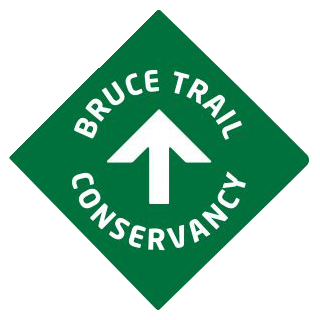General Hike Information
Bruce Trail Users' Code
While exploring the Bruce Trail please abide by the Bruce Trail Users' Code:
- Hike only along marked routes. Do not take short cuts.
- Obey all signage.
- Use the stiles. Do not climb fences.
- Respect the privacy of people living along the Trail.
- Leave the Trail cleaner than you found it. Carry out all litter.
- Use a portable stove. No open fires are allowed on the Trail.
- Camp only at designated camp sites.
(Read more about Camping along the Bruce Trail) - Leave flowers and plants for others to enjoy.
- Do not damage live trees or remove bark.
- Where dogs are permitted, keep dogs on a leash and under control at all times.
- Do not disturb wildlife and farm animals.
- Leave only your thanks and take nothing but photographs
Please note the Bruce Trail runs through land that is owned by over 100 different landowners, thanks to generous agreements with those landowners.Those agreements can be jeopardized when trail users fail to follow the trail users code, and in some cases trails end up being re-routed, often along roads.
How to Follow the Trail - Read the Blazes
The trail is marked with white (main trail) or blue (side trail) 6" x 2" blazes. You will find these blazes on trees, posts, rocks and stiles.
Things to Know About Organized Hikes
Please arrive 15 minutes before departure time.
All hikers are required to sign a waiver.The Niagara Club, the Bruce Trail Conservancy, and all unpaid volunteers assume no liability for any persons. YOU HIKE AT YOUR OWN RISK.
- Always carry your Ontario Health Card and identification.
- Carry an adequate amount of water and high energy food. Everyone’s needs are different. Better to carry too much than not enough.
- Stay with the group when hiking - don't go ahead or fall behind.
- Please follow any instructions given by the leader.
- Tell the leader if you need to leave the hike for any reason.
- Proper footwear is required.Hiking boots are the best footwear to keep you safe, dry and happy along the Bruce Trail.
- Hiking poles as well as icers are recommended for winter hiking on snow and ice.
- Be honest with yourself when judging your ability to manage the length, speed and difficulty of the hike you wish to attend, for the benefit of the group - if in doubt, call the leader.
While there are a few portions of the Bruce Trail within Conservation Areas that are wheelchair accessible, use of the majority of the Trail is suitable for foot traffic only. To participate in an organized hike, you need to be able to complete the specified length of the hike on your own or with your own support person within the specified time.
Getting Started
No matter how physically fit you are, we suggest that people who are new to hiking begin with the shorter hikes. At the end of that first hike, you will have a better idea of where you can go from there. Get to know your ability and choose the hike that is right for you.
If you want some guidance on where to begin, what to wear and what to take along, consider enrolling in Hiking 101, a 3-day introductory course for members and non-members.

